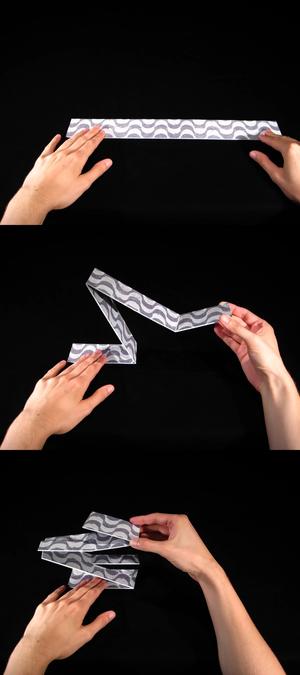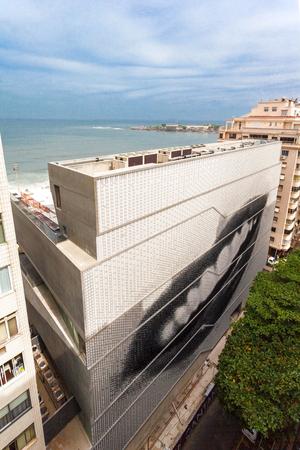MUSEUMOFIMAGE&SOUND
RIODEJANEIRO,BRAZIL
The Museum of Image and Sound (MIS) faces Rio de Janeiro’s famed Copacabana Beach. Given the richness of Rio’s diverse population and the many challenges of urban inequality, Copacabana Beach stands out as Rio’s greatest democratic asset. The beach unifies the city and its people in a lively civic embrace of natural beauty and urban spectacle, from the scale of a singular, suntanned body to the mass event that draws millions of people every New Year’s Eve.
The museum occupies the site of the former Help nightclub, a notorious hotbed of drugs and prostitution demolished by the city in 2010. In its place, the MIS presents Rio’s rich cultural heritage in exhibitions of taped samba and choro music, original film prints and video art, comedy acts, telenovela recordings and scripts, and a floor dedicated to a collection of Carmen Miranda’s headdresses, costumes, jewelry, and shoes. Yet the postcard views of the beach and surrounding mountains are perhaps the museum’s most potent asset. While Copacabana and its Avenida Atlantica promenade, designed by Roberto Burle Marx, are the birthright of all residents, the hotels and apartments overlooking the beach are strictly private. As a result, the panoramic views are available to tourists and wealthy residents but off-limits to most locals. The privilege of an elevated perspective is thus symptomatic of a widening gap between the rich and the poor.
The architecture of the Museum of Image and Sound responds to this cultural, social, and economic context. The building is conceived as a continuation of Avenida Atlantica, which radically extends up the facade of the museum. The “vertical boulevard” carries the promenade’s inclusive ethos into the building: it traverses indoor and outdoor spaces, branches into and out of galleries and education spaces, and culminates in a lushly planted rooftop, cinema, and bar.
This vertical circulation sequence connects the street level to the top of the building, granting sweeping views of the ocean to all visitors—both ticketed and unticketed. Leave the beach, shower off at the base of the building, climb the switchback stairway, sip on a caipirinha, and bask in the view or watch the screening of a new film.
Inspired by the Brazilian cobogó, the facade is a perforated screen that provides shade while also admitting light and views. From within, the screen precisely curates views to the outside at each level. Thousands of cylindrical tubes, clustered in parallel groups, aim in various directions, orienting views toward the sidewalk, the beach, the horizon, Sugarloaf Mountain, and the sky. The facade system produces an uncanny effect in which the view appears to move with the viewer. The back of the building is corrugated and clad with photographic tiles that create a lenticular mural. When seen from one side, the tiles combine to reveal Carmen Miranda’s eyes; from the other, they form her lips.
The Museum of Image and Sound is a collaboration with Indio Da Costa Architects and museographers T+T Projetos (Daniela Thomas and Felipe Tassara).

 View of vertical boulevard along MIS’s facade
View of vertical boulevard along MIS’s facade View of roof at night
View of roof at night- Site Photo January 2018
| Size (GSF) | 107000 | Location | Rio de Janeiro, Brazil |
| Commission2009 | Completion2024 |
| Partners | Elizabeth Diller,Ricardo Scofidio,Benjamin Gilmartin,and Charles Renfro |
| Project Leader | Chris Andreacola |
| Designers | Anthony Saby,Jorge Pereira,Christopher Kupski,Matt Ostrow,Andrew Colopy,and Patrick Ngo |
| Competition Team | Amber Foo,Jose Vidalon,Mary Broaddus,Robert Loken,Yoon-Young Hur,Ben Mickus,Charles Curran,Eric Rothfeder,Felipe Ferrer,Scott Shell,and William Ngo |
| Indio da Costa Architects | Associate Architect |
| T+T Projetos | Museography Consultant |
| Hugo Sukman and André Weller, FRM | Curation |
| JKMF (Julio Kassoy e Mario Franco) | Structural Engineer |
| Robert Silman Associates | Structural Engineer |
| PhD | Concrete Consulting |
| Consultrix | Foundations |
| Limonge de Almeida Consultoria e Projetos | Miscellaneous Structural Steel |
| LD Studio | Lighting Design |
| Burle Marx Escritório de Paisagismo | Landscape |
| QMD Consultoria | Facade |
| Cetimper | Waterproofing |
| Atelier Ten | LEED Consultant |
| Casa do Futuro | LEED Consultant |
| Termoplan | Mechanical Engineering |
| Cemope | Electrical & Plumbing |
| Harmonia Acustica | Acoustic Consultants |
| Fisher Dachs Associates | Theater Consultant |
| Fabrica Arquitetura | Cinema Consultants |
| Kreimer | Theater Consultant |
| PS2 | Identity & Graphics |


